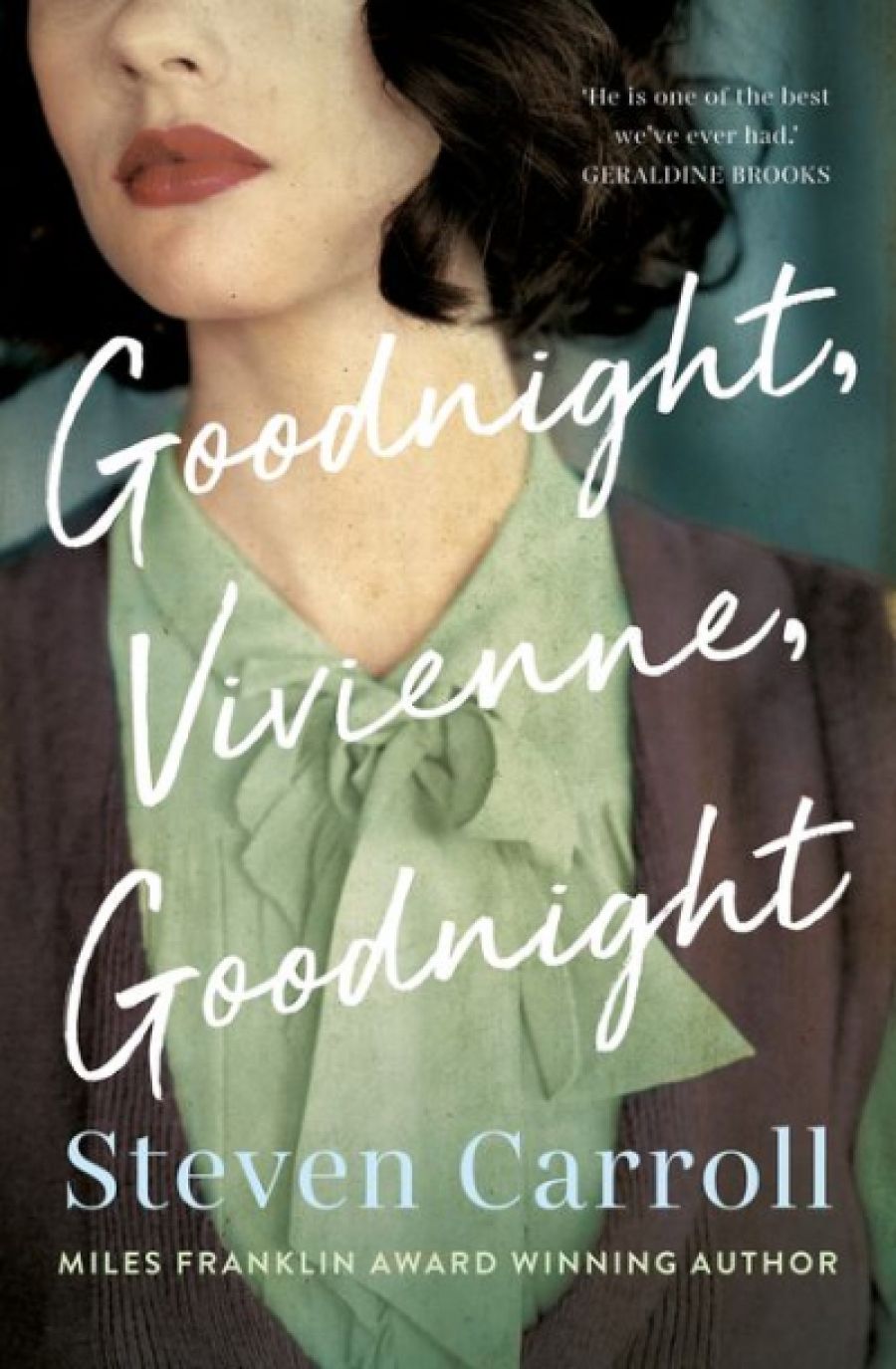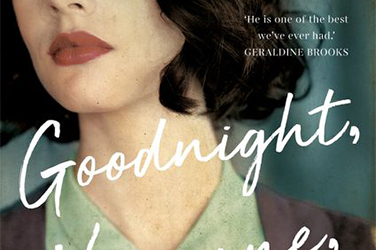
- Free Article: No
- Contents Category: Fiction
- Review Article: Yes
- Article Title: Silence and screams
- Article Subtitle: The end of Steven Carroll’s T.S. Eliot quartet
- Online Only: No
- Custom Highlight Text:
Early in Steven Carroll’s novel Goodnight, Vivienne, Goodnight, a middle-aged woman contemplates her own existence: ‘Vivienne, Vivie. Viv. Now distant, now near. Who was she? The Vivienne now sitting in the gardens of Northumberland House, Finsbury Park, is contemplating the question.’ This Viv is Vivienne Haigh-Wood, the first wife of T.S. Eliot – or Carroll’s fictional rendition of her. Northumberland House is an asylum where, by 1940, Viv has lived for several years. Her previous actions include not accepting the end of her relationship with Eliot, dabbling in fascism (‘Did you tell him I just liked the uniform?’), and asking a police officer at five one morning if it’s true her husband has been beheaded. Institutionalised, she now lives in quiet defiance of other people’s perceptions and diagnoses of her. And with the help of her friend Louise and a group called the Lunacy Law Reform Society, she is about to do a runner.
- Article Hero Image (920px wide):

- Article Hero Image Caption: Steven Carroll (photograph by Rebecca Rocks/HarperCollins Australia)
- Alt Tag (Article Hero Image): Steven Carroll (photograph by Rebecca Rocks/HarperCollins Australia)
- Featured Image (400px * 250px):

- Alt Tag (Featured Image): Patrick Allington reviews 'Goodnight, Vivienne, Goodnight' by Steven Carroll
- Book 1 Title: Goodnight, Vivienne, Goodnight
- Book 1 Biblio: Fourth Estate, $32.99 pb, 239 pp
- Book 1 Readings Link: booktopia.kh4ffx.net/Vyjb6E
Goodnight, Vivienne, Goodnight is the last of Carroll’s four novels that use the life, times, and poetry of T.S. Eliot to ponder the messy ways people interact and, especially, the inner worlds of those people. Carroll’s third-person narrator, like the character herself, asks who Viv is – in a probing but sympathetic way. What is her state of mind, and what was it before? How does she see the past and the future? How does she judge her marriage, long over except in law? What was her part in the creation of the eminent poet T.S. Eliot?
Eliot – sometimes Tom, sometimes T.S. – intrudes upon the novel as if he were the humid air that Viv and readers must inhale. And although Eliot and various other characters line up to judge Viv’s well-being, her past behaviour, her role in a failed marriage, Carroll works hard to emphasise Viv’s perspective, her clarity, her calmness. At one point, Viv tells Louise to ‘watch out for that awful other woman who everybody mistakes me for’.
 Vivienne Haigh-Wood Eliot by Lady Ottoline Morrell, 1921 (photograph via Alamy)
Vivienne Haigh-Wood Eliot by Lady Ottoline Morrell, 1921 (photograph via Alamy)
After Viv escapes from Northumberland House, she goes into hiding. She hopes to benefit from an old law that says an escapee from an asylum can stay free if she is not captured and returned within thirty days, and if a judge so agrees. She is free enough to be reunited with her beloved terrier, Polly, who, Louise says, is like a child from Viv and Tom’s dire marriage. But it is only half a win: she is not free enough to go where she wants when she wants under her own name.
The task of finding Viv falls to detective sergeant Stephen Minter, a young war veteran with a bad knee. Minter is the son of Austrian migrants, people who, like Eliot, have made a new life in England. But whereas Eliot is ‘a kind of Winston’ when it comes to his role in the war effort, Stephen’s parents face internment.
Stephen’s boss makes it clear that he must find Viv, given Eliot’s public status and connections. In Viv’s words, ‘Mad wife on the loose’. Stephen is clever, thorough, and creative as he uses others not just to look for Viv but understand her – a novelist’s dream detective. He sees that Louise is lying when she claims not to have helped Viv escape; he senses, too, Louise’s anti-Semitism. He finds Eliot’s demeanour, his Englishness to be ‘a sort of performance’ – and, in any case, he does not believe in geniuses. Before he visits Eliot at the Faber offices, Stephen reads East Coker and a collection of Eliot’s poems. He reacts with distaste: ‘Stephen feels the need to wash his hands after putting the book down.’
Goodnight, Vivienne, Goodnight contains layers of tension beyond whether Viv can stay hidden from Stephen and be permanently free. There is Carroll’s excruciating, shard-like depiction of Viv and Tom’s strained, dysfunctional relationship, what Viv calls ‘a marriage of silence – and screams’. And then there is the wrestling match Carroll gifts readers, between what is (or might be) the real story of Viv versus his fictionalisation of events and Viv’s thoughts – and in turn, what is (or might be) the real T.S. Eliot, a much contested canonical figure, as against Carroll’s invention of Eliot. This novel – like the three that precede it (The Lost Life [2009], A World of Other People [2013], A New England Affair [2017]) – is more convincing and compelling if the reader resists the temptation to compare Carroll’s creation of Eliot with the real man. But such resistance is hard work.
One of Carroll’s skills is his capacity to dwell on the inner worlds of his characters in a way that defies triteness. In Goodnight, Vivienne, Goodnight, he gives Viv a capacity for self-reflection and an ability to weigh the past in a sober, honest way without it crushing her all over again. There are glimpses of humanity in the way Carroll depicts all his characters – including his version of a mostly bloodless, snooty T.S. Eliot. As a creator of fictional humans, Carroll is compassionate and respectful towards his inventions. It’s no small reason why this novel succeeds.
When I read The Lost Life at the time of its release, I considered it a modest achievement compared to Carroll’s Glenroy series of novels about outer-suburban Melbourne. A decade later, both series of novels are complete. I still consider that Carroll’s great strength as a novelist – his ability to dwell on particular moments, to slow down time and look hard and long at bits and pieces of the world – is best displayed in the Glenroy novels. Nonetheless, the Eliot quartet have a searching and delicate, almost frail, beauty. And the four individual novels come together to make a tense, echo-laden whole.


Comments powered by CComment